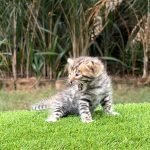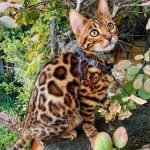The Bengal Fuzzies
I am sure we have all heard of the Ugly Duckling that turns in to a beautiful swan. It is a literary fairy tale by Danish poet and author Hans Christian Andersen.
A similar trait has been passed down from the Asian Leopard Cat to all bengals kittens
At around 4 weeks old a wild ALC (Asian Leopard Cat) cub will start to leave the nest and catch its own prey. At the risk of being attacked by predators Mother Nature gave them the gift of guard hairs to help with camouflage, some are even born with them.
For breeders it can be hard when we part with them and receive kitten updates around 6 - 12 month old showing perfect contrast and clarity. We often kick ourselves that we let that one get away.
Breeders often take photos around 4 weeks of age. This will give you a good idea what the kitten will look like when it’s older after the 'fuzzies'.
Over the last 30 years I have had a number of pet owners ask me on the pick up day if it’s the same kitten that they reserved.
There seems to be 2 types of 'fuzzies' that I’ve come across over the years. The most common is long grey hairs (we call them guard hairs)
They make the kitten look very ticked (a salt and pepper look).
Then we have another where the hair seems longer and looks quite greasy.
The fuzzy stage starts clearing up around 6 month old but some bengals don’t reveal their true contrast until 2 years of age.
Unfortunately a number of years ago we had a hard drive malfunction and lost a lot of photos and data but here are some examples of kittens/cats and the fuzzies.
Migaloo Zelda
Migaloo Kenji
Migaloo Aurora









